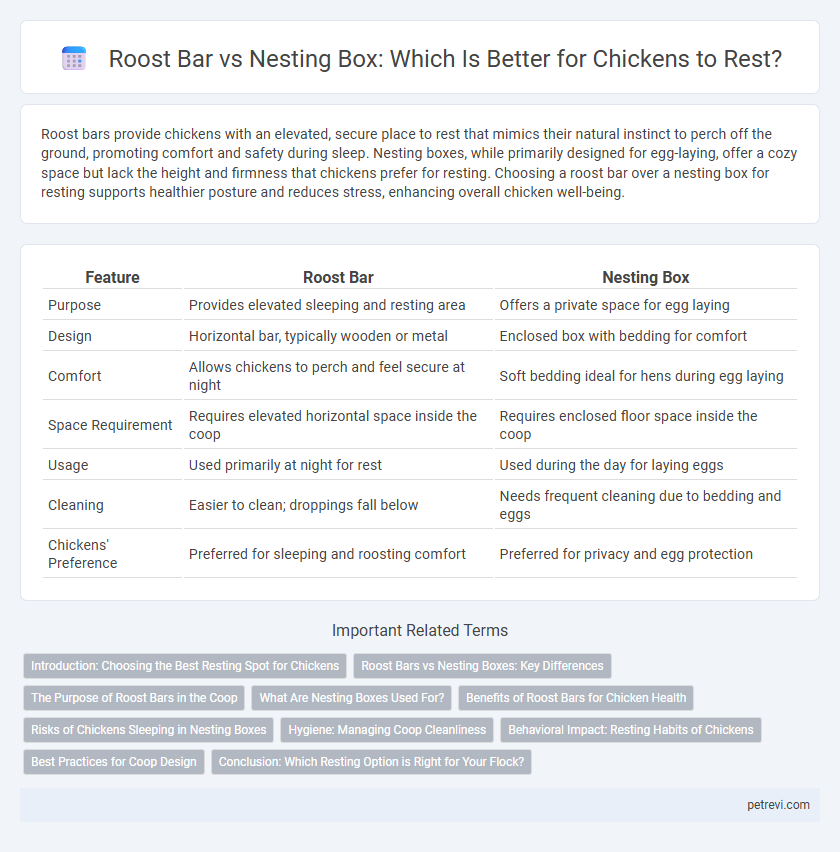Roost bars provide chickens with an elevated, secure place to rest that mimics their natural instinct to perch off the ground, promoting comfort and safety during sleep. Nesting boxes, while primarily designed for egg-laying, offer a cozy space but lack the height and firmness that chickens prefer for resting. Choosing a roost bar over a nesting box for resting supports healthier posture and reduces stress, enhancing overall chicken well-being.
Table of Comparison
| Feature | Roost Bar | Nesting Box |
|---|---|---|
| Purpose | Provides elevated sleeping and resting area | Offers a private space for egg laying |
| Design | Horizontal bar, typically wooden or metal | Enclosed box with bedding for comfort |
| Comfort | Allows chickens to perch and feel secure at night | Soft bedding ideal for hens during egg laying |
| Space Requirement | Requires elevated horizontal space inside the coop | Requires enclosed floor space inside the coop |
| Usage | Used primarily at night for rest | Used during the day for laying eggs |
| Cleaning | Easier to clean; droppings fall below | Needs frequent cleaning due to bedding and eggs |
| Chickens' Preference | Preferred for sleeping and roosting comfort | Preferred for privacy and egg protection |
Introduction: Choosing the Best Resting Spot for Chickens
Roost bars provide chickens with elevated perches that mimic their natural instincts to sleep off the ground, promoting better health and hygiene by reducing exposure to moisture and parasites. Nesting boxes, designed primarily for egg-laying, offer a cozy, enclosed space but lack the elevated platform necessary for optimal rest. Selecting roost bars over nesting boxes for resting supports improved chicken well-being and natural behavior patterns.
Roost Bars vs Nesting Boxes: Key Differences
Roost bars provide elevated perches where chickens can sleep comfortably off the ground, promoting natural resting behavior and reducing the risk of parasites, while nesting boxes offer sheltered, private spaces primarily designed for egg-laying. Roost bars are typically made from durable wood or metal and support multiple birds simultaneously, maximizing coop space efficiency. In contrast, nesting boxes prioritize comfort and privacy with softer bedding materials, encouraging hens to lay eggs in a secure environment rather than serving as a resting spot.
The Purpose of Roost Bars in the Coop
Roost bars provide chickens with elevated perches that satisfy their natural instinct to rest off the ground, promoting better sleep and reducing the risk of parasites. Unlike nesting boxes designed solely for egg-laying, roost bars serve as a dedicated space for nighttime resting, enhancing flock comfort and health. Properly installed roost bars also facilitate airflow and cleanliness within the coop by minimizing contact with manure.
What Are Nesting Boxes Used For?
Nesting boxes provide hens with a secure, comfortable space to lay eggs, mimicking natural nesting environments that encourage consistent egg production. These boxes are typically filled with soft bedding material, reducing egg breakage and maintaining cleanliness. Unlike roost bars, nesting boxes are specifically designed to support egg-laying behavior rather than resting or perching.
Benefits of Roost Bars for Chicken Health
Roost bars offer significant benefits for chicken health by promoting natural sleeping positions that improve joint comfort and reduce foot problems such as bumblefoot. Elevated roosting surfaces allow chickens to stay off damp or dirty ground, minimizing the risk of infections and enhancing respiratory health. Properly designed roost bars also support better social hierarchy management, reducing stress and aggressive behaviors within the flock.
Risks of Chickens Sleeping in Nesting Boxes
Chickens sleeping in nesting boxes face higher risks of egg breakage and contamination from feces, increasing the likelihood of bacterial infections such as salmonella. Nesting boxes are designed for egg-laying, not resting, leading to overcrowding and stress among hens using them as roosts. Roost bars provide elevated, clean, and safer resting spots, reducing these health hazards and promoting better flock hygiene.
Hygiene: Managing Coop Cleanliness
Roost bars allow chicken droppings to fall beneath, making it easier to clean the coop floor regularly and reducing the risk of ammonia buildup that harms bird health. Nesting boxes require frequent spot cleaning to prevent accumulation of waste and moisture, which can create a breeding ground for bacteria and parasites. Proper hygiene includes regular removal of droppings under roost bars and daily inspection of nesting boxes to maintain a clean, disease-free environment.
Behavioral Impact: Resting Habits of Chickens
Chickens exhibit distinct resting habits influenced by roost bars and nesting boxes, with roost bars promoting natural perching behavior essential for nighttime security and social hierarchy. Nesting boxes primarily serve egg-laying functions but also provide a secluded resting space, reducing stress in hens during daylight hours. Optimal chicken welfare is achieved by integrating both structures to accommodate their instinctive behaviors and resting preferences.
Best Practices for Coop Design
Roost bars should be installed at varying heights to accommodate chicken hierarchy and reduce aggression, with a recommended width of 2-3 inches for comfortable gripping. Nesting boxes must be lined with soft, absorbent material and placed in quiet, dimly lit areas to encourage egg laying and minimize stress. Proper ventilation and regular cleaning of both roost bars and nesting boxes are essential to prevent disease and promote healthy chicken rest behavior.
Conclusion: Which Resting Option is Right for Your Flock?
Choosing between a roost bar and a nesting box for chicken resting depends on your flock's specific needs and behavior. Roost bars provide elevated resting spots that promote natural perching instincts and better ventilation, ideal for larger flocks. Nesting boxes offer enclosed, comfortable spaces primarily for laying eggs, supporting hens during rest but are less suitable for overnight perching.
Roost Bar vs Nesting Box for Chicken Resting Infographic

 petrevi.com
petrevi.com